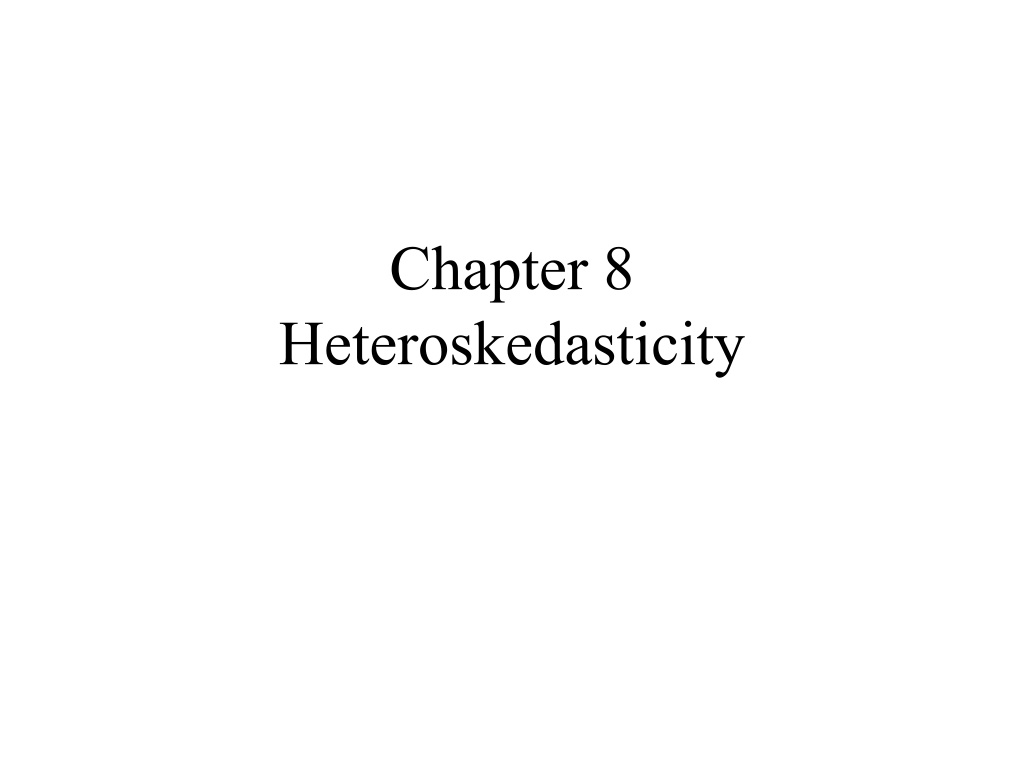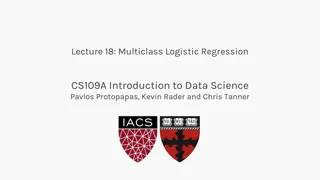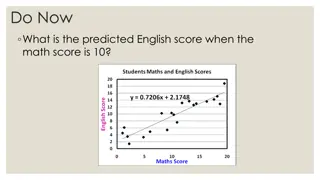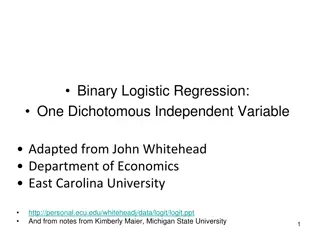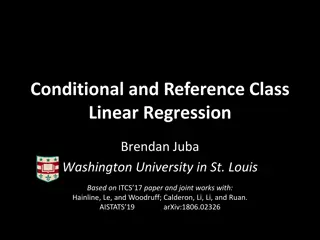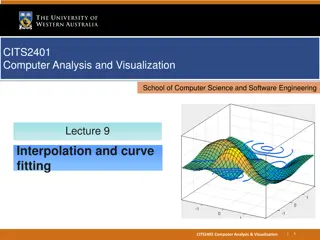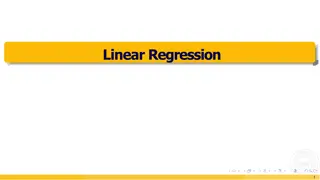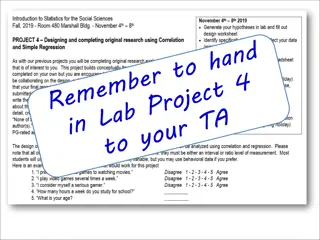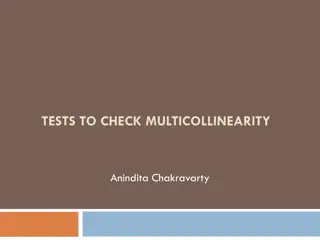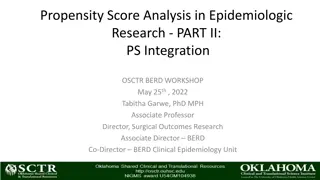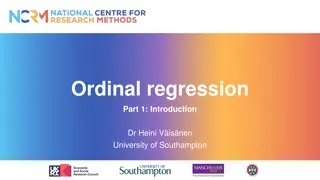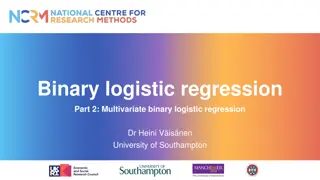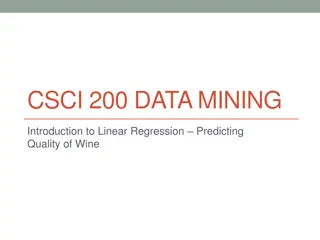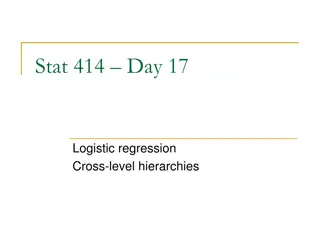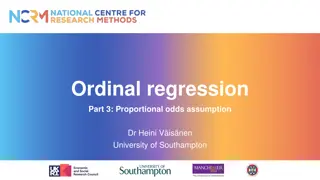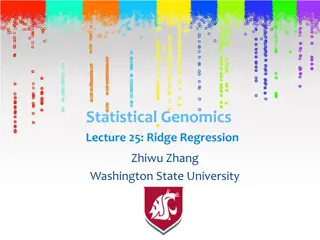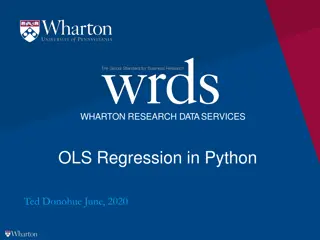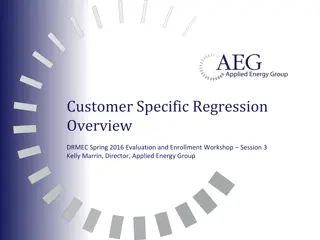Understanding and Correcting Heteroskedasticity in Regression Analysis
Heteroskedasticity is a common issue in regression analysis where the variance of errors is not constant. This can lead to biased estimates and affect hypothesis testing. Learn how to identify, test for, and correct heteroskedasticity using robust estimators and model adjustments to ensure the reliability of your statistical analysis.
Download Presentation

Please find below an Image/Link to download the presentation.
The content on the website is provided AS IS for your information and personal use only. It may not be sold, licensed, or shared on other websites without obtaining consent from the author. Download presentation by click this link. If you encounter any issues during the download, it is possible that the publisher has removed the file from their server.
E N D
Presentation Transcript
Chapter 8 Heteroskedasticity
Learning Objectives Demonstrate the problem of heteroskedasticity and its implications Conduct and interpret tests for heteroscedasticity Correct for heteroscedasticity using White s heteroskedasticity-robust estimator Correct for heteroscedasticity by getting the model right
What is Heteroscedasticity? Hetero = different Scedastic from a Greek word meaning dispersion
CO2Emissions vs National Income 8.0e+06 China 6.0e+06 USA CO2(kt) 4.0e+06 India 2.0e+06 Russia Japan Germany 0 0 5.0e+06 1.0e+07 1.5e+07 GNI(Millions of US$)
The Problem The population model is: Y = + + + X X 0 1 1 2 2 i i i i The errors come from a distribution with constant standard deviation What if the standard deviation is not constant? => Heteroskedasticity Maybe it s higher for higher levels of X1i, X2i, or some combination of the two.
The Good News As long as you still have a representative sample the error on average is zero and your estimates will still be unbiased
The Bad News But the errors will not have a constant variance That could make a big difference when it comes to testing hypotheses and setting up confidence intervals around your estimates. Heteroskedasticity means that some observations give you more information about than others.
Example 1: Variance is correlated with RH Variable What happens if we drop one of these? Figure 8.1. 2010 CO2 Emissions for 183 Countries. Data Source: World Bank World Development Indicators. http://data.worldbank.org/data-catalog/world- development-indicators
Using Average GNI per Person Now what happens if we drop one of these? Still have lots of heteroscedasticity, but the extremes are less extreme than in the first figure
Example 2: Working with Average Data Yj=b0+b1Xj+ej Model for person j: in 1 n = = + + , Y X You estimate (country i): 0 1 i i i i ij = 1 j in j ( ) Var ij i n n n 2 2 = 1 = ( ) = = = 2 ( ) , so Var Var ij i 2 i 2 i n i The variance is lower for bigger countries (which makes sense, right?)
Example 3: Modeling Probabilities Suppose you drop a laptop to see whether it breaks Bi=1if laptop breaks, 0otherwise p=Prob(breaks) (1-p) = Prob (doesn t break) Variance = p(1-p) HEIGHT=height you drop the laptop from = + HEIGHT + B 0 1 i i i Low height: never breaks; Large height: always breaks; in between, the variance is greater than zero
Example 4: Moving Off the Farm (Ch. 7) = + + AGL 1 0 i i PCY i Variance decreases to almost nothing in rich countries (where nobody wants to do hired farm work)
Two Solutions 1. Test and fix after-the-fact (ex-post) 2. Change the model to eliminate the heteroscedasticity
Testing: Let Every Observation Have Its Own Variance Heteroskedasticity means different variances for different observations The squared residual is a good proxy for the variance i2 It s different for each observation It even looks like a variance! So why not regress the squared residuals on all the RH variables and see if there s a correlation?
Breusch-Pagan Test Estimate the regression: Y = + + + b b X b X e 0 1 1 2 2 i i i i Save the residuals and square them Regress the squared residuals on X1 and X2 For the two RH variable case: = + + + 2 i e X X u 0 1 1 2 2 i i i Under homoscedasticity, NRa2 is distributed as a chi- squared with df equal to the total number of right-hand variables in the regression (df=2).
Whites Test (More Flexible than Breusch-Pagan. Why?) Estimate the regression: = + i i Y b b X Save the residuals and square them Regress the squared residuals on X1, X2, their squares, and their interactions For the two RH variable case: + + b X e 0 1 1 2 2 i i = + + + + + + 2 i 2 i 2 2 e X X X X X X u 0 1 1 2 1 3 2 4 5 1 2 i i i i i i Under homoscedasticity, NRa2 is distributed as a chi- squared with df equal to the total number of right-hand variables in the White regression, a (here, a=5).
Set up your Breusch-Pagan or White test = 2 i 2 : for all vs i :not H H H 0 1 0 2 a NR Test statistic: 2 a 2 a NR Reject the null hypothesis if: Rejecting the null implies that have heteroskedasticity
White Test of Moving Off the Farm = + + + 2 i 2 e PCY PCY u 0 1 2 i i i Variables in White's Auxiliary Regression Estimated Coefficient Standard Error PCY -38.27 0.91 418.11 12.41 0.37 61.47 PCY-squared Constant R-squared 0.14 95.00 13.09 N N*R-squared Critical Chi- Square at =.05 5.99 White s test shows a quadratic relationship between PCY and the variance exceeds the critical Chi-Square value, so we reject the null of homoskedasticity 2 a NR
Fixing the Problem at Its Source If your data are averages: = + + Y X 0 1 i i i 2 ( ) = Var i n i We know the cause of the heteroskedasticity, so transform the regression equation by multiplying through by in = + + nY n n X n 0 1 i i i i i i i 2 i n 2 n = = 2 ( ) Var n i i 2 i
Fix It By Getting the Model Right Fit a line instead of a cubic and it LOOKS like the variance is related to Q (heteroskedasticity) Fit a cubic and you should get rid of the problem
What If the Models Right and There s Still Heteroskedasticity? White s solution: Replace s2 with when calculating the variance Before: 2 ie N 2 i 2 x s 2 s = = 2 b = 1 N i s 2 N 1 2 i x 2 i x = 1 i = 1 i N 2 2 i x e White s Method (For simple regression; for multiple, use v method): Heteroskedasticity- Consistent Estimator, HCE Stata: reg y x1 x2, robust i = = 1 i Vb 1 2 N 2 i x = 1 i
Moving Off the Farm With and Without White s Correction Here, the heteroskedasticity is not enough to change hypothesis test results, but it has a big effect on confidence intervals The corrected standard error is almost 50% larger! In other cases, test results can change, too
White-corrected Confidence Intervals Uncorrected Regression: = 65 71 . . 4 04 . 1 * 98 65 71 . . 8 01 Robust Regression: 98 . 1 * 86 . 5 = 65 71 . 65 71 . 11 61 . In this example, we get a confidence interval that is quite a bit smaller than it should be when we ignore heteroskedasticity
Log Regression Gets Rid of Heteroskedasticity in CO2 Study Taking the log compresses the huge differences in income evident in figure 8.2. Country GNIs range from $0.19 billion to $15,170 billion. The log ranges from 1.66 to 9.63.
Heteroskedasticity-Robust Standard Errors Uncorrected Robust = + + = + + 2 12282.71 0.44 (36713.99) (0.03) 2 12282.71 0.44 (16752.29) (0.12) CO GNI e CO GNI e i i i i i i Sample Size = 182 Sample Size = 182 5% critical value for 2(2) = 5.99 R-squared = 0.61 R-squared = 0.61 White test: NR2 = 50.84 Uncorrected Robust 2 2 CO POP GNI POP CO POP GNI POP = + + = + + 2155.05 0.20 2155.05 0.20 i i i i e e i i i i i i (458.28) (0.02) (407.25) (0.04) Sample Size = 182 Sample Size = 182 R-squared = 0.33 R-squared = 0.33 White test: NR2 = 16.52 Uncorrected Robust = + + = + + ln( 2 ) i 1.09 (0.27) (0.026) 1.01ln( ) ln( 2 ) i 1.09 (0.25) (0.023) 1.01ln( ) CO GNI e CO GNI e i i i i Success! Sample Size = 182 Sample Size = 182 R-squared = 0.90 R-squared = 0.90 White test: NR2 = 0.73
What We Learned Heteroskedasticity means that the error variance is different for some values of X than for others; it can indicate that the model is misspecified. Heteroskedasticity causes OLS to lose its best property and it causes the standard error formula to be wrong (i.e., estimated standard errors are biased). The standard errors can be corrected with White s heteroskedasticity-robust estimator. Getting the model right by, for example, taking logs can sometimes eliminate the heteroskedasticity problem.
